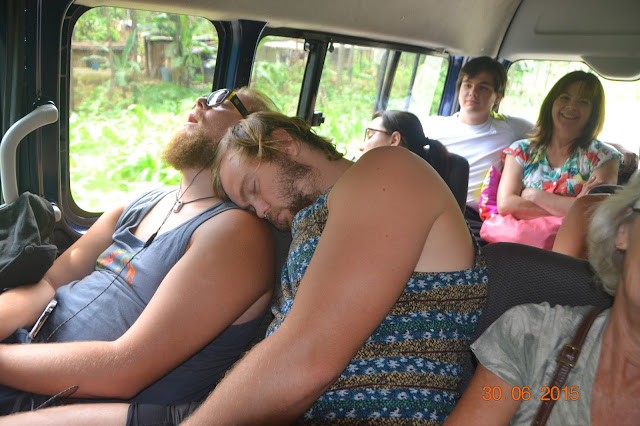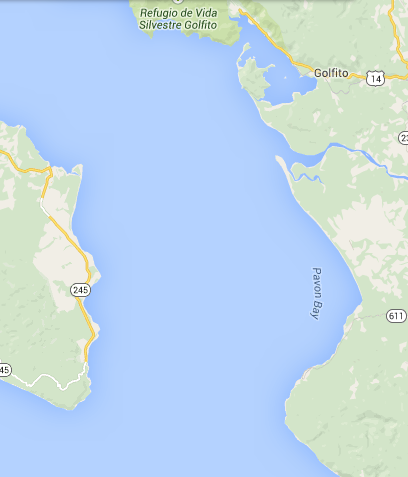However, now that he is gone we can do some land travel. We are just back from a three week grand tour of Guatemala we took with some great new Canadian friends. It was fun moving from place to place every couple days, figuring out transportation and lodging as we went.
Travel arrangements were actually pretty easy, as we chose to travel by shuttle van. Vans go door to door, picking up at the hotel or hostel and dropping off at the front door of the next place. Sometimes there were only the four of us, but mostly they were full, usually with young backpackers from all over the world. (It was nice to get out of the geriatric cruising community for a while.) We stayed in hostels for twenty to thirty bucks a night in a private room with bath. The shuttles were about what a Greyhound would cost in the states. Total expenses. assuming we didn't eat out high end gringo, were about a hundred bucks a day.
 |
| Van travel on the morning after. |
While there we saw some demonstrating. Guatemala is going through one of its frequent political dramas. People are trying to oust the current corrupt president and former genocidal army General. He was taking money from everywhere, causing some of the social services, like public hospitals, to run out of money. The vice president had just been forced out for some sort of customs scam. Business as normal in this troubled land.
Guatemala is a beautiful land, with stunning mountain views, lakes nestled amongst active volcanos, rivers buried deep in jungle lined canyons, and pristine colonial towns.
 |
| Lake Atitlan |
 |
| Antigua |
 |
| Lanquin |
 |
| Lanquin |
 |
| Rio Dulce |
But for me the real attraction are the Mayan ruins and museums.
 |
| Tikal |
 |
| Tikal |
Copan
In Copan there were several ceremonial amphitheaters. Judy is sitting where the king used to stand during sacrifices that required the most noble blood in the land....his. The blood was obtained by piercing various parts of his anatomy, most often his penis, with a sting ray barb.
All the males in the kings family gave blood for ceremonial use. One guide told me during the draught in the ninth and tenth centuries, the noble family almost bleed out supplying blood for constant blood sacrifices to appease the rain god. The weakened noble families suffered chronic pain and illness. He believes this was an factor in the collapse of the Mayan cities.
Other amphitheaters in Copan were used for more pleasant pastimes,,,,,getting stoned and playing ball. Getting stoned on mushrooms was a common occurrence during ceremony's.
 |
| Copan |
 |
| Copan |
 |
| Crocodile
|
| Maya warrior |
He is a very handsome fellow by Maya Classic Era standards. The sloping forehead and protruding lips and teeth were much admired by the nobility. The strange look was intended to be proof that the nobles were descended from the gods. Boards were used to squeeze the foreheads back and some sort of orthotic device pushed the teeth and lips out. They also were known to paint the tips of children's noses to develop crossed eyes. Wonder what they could have done with collagen.
At his side in the basket are the remains of his latest triumph over one of the gods of the underworld.
On the other side of the entrance is another Mayan. At first I thought it was the now part of a "then and now" tableau, with the fierce warrior now a peaceful farmer.
He also is a handsome fellow, as are the Mayans in general.
What makes me wonder about the "then and now" thing is what he's got in his basket. What's this peasant farmer, with his hands full of maize, doing with a severed head?
The artist may have been reflecting a commonly felt wariness felt by the elites toward Mayans, who make up about 50% of the population. It took the Conquistadors more then a hundred and fifty years and a great many lives before the last of the Mayans were overcome. They were a tough group, battle hardened by almost constant tribal warfare.
The tribal nature of Mayan society was a principle reason for the lengthy pacification process. There was no central state the Spanish could conquer in one fell swoop. In Guatemala the Mayan cities were independent of each other, much like the city states in ancient Greece. Each tribe had to be subdued separately. There are twenty Mayan languages currently spoken in Guatemala today, indicative of their continuing tribal nature.
Defeated Mayans were forced to leave their ancient homes and migrate to towns built near newly forming plantations. This concentration enabled quicker acculturation and created a labor pool for the plantations to draw on. The rational was that since the conquerors were saving Mayan souls by bringing them Christianity, the Mayans owed the Spanish tribute and labor.
Initially the plantations had no claim on the land they were using, as the king granted only the right to the labor of the Mayans This didn't bother early colonizers who viewed cheap labor as the primary source of wealth. But during the Spanish depressions of the 17th century, the Spanish Crown, in dire need for money began selling the "crown lands" in the new world. Land that could support cash crops soon passed from Mayan ownership to the privileged Spanish.
In the coastal lowlands the disposed Mayans gradually integrated with the Spanish, intermarried and adopted Spanish as their primary language. But in the highland areas things were different. Spanish plantation owners were not interested in land that was unsuited for cash crops. The land remained in Mayan hands. Ancient village associations continued to function and highland Mayans "fugitives" returned home, escaping the new Spanish towns. Spanish attempts at rounding up the fugitives was not vigorous, and the highlands became a refuge.
 |
| A Mayan lady working in her field in the highlands of north central Guatemala. |
 |
| The volcanic soil looks very rich. |
 |
| Across the valley is an active volcano. In the center right of the picture are a couple steam plumes from a geothermal generating plant. |
 |
| A river flows through the valley floor. |
 |
| Small plots extent up the mountain side. Every arable acre is planted |
But the refuge came under serious attack after Guatemala won its independence from Spain. This assault was lead by lawyers, as it involved stealing, all fair and square, Mayan land through a legal process. Shortly after Guatemala gained independence the central government passed a decree that all farm lands, even the ancient communal lands of the Mayans, must be deeded to individuals. Unfortunately the highland Mayans, who were not integrated with the Spanish, didn't get the word, but people in the lowlands did. They flocked to place claims on much of the lower highlands. Coffee had become an enormous cash crop and these lands were perfect. The disposed Mayans soon had insufficient land to feed themselves. They were forced to take jobs in the new coffee plantations. Money was loaned to them by plantation owners in amounts they could not repay and debtors could not leave plantations to whom they owed money.
There was one more assault on the Mayans. During the last half of the twentieth century non Mayan "red communist" rebel groups formed to resist the central government. The numbers of rebels was never significant and they lacked the weapons needed to really threaten the government. Elites and corporate land owners pressed the government to use the unrest as an excuse to attack the largely uninvolved Mayans, rationalizing these attacks as necessary to protect the state from "internal enemies". About 200,000 were killed and over 600 villages were destroyed. A United Nations truth commission found the central government guilty of organizing and conducting genocide.
The US supported the central government by providing material support and trained government troops in counter insurgency and jungle warfare, fully knowing, at least at some level, what was happening to the uninvolved Mayans in the Guatemalan highlands.
Peace accords with in insurgents were concluded in the late 90's, but conditions on the ground remain the same. Mayans still do not have enough land to feed themselves and malnutrition is endemic in the Mayan population.
Peter Rohloff, an American doctor who runs a group of medical clinics in rural Guatemala told a reporter:
"The most incredible thing about stunting in Guatemala is how completely total an experience it is for rural communities. All children are at least six or eight inches shorter than they should be. In a family that's extremely impoverished, you will see very extreme cases of chronic stunting where children who are twelve years old, look as if they were four or five.
But stunting is not just about height. With malnourishment comes greater susceptibility to disease and infection, impaired cognitive function and even lower IQ. Stunted kids are more likely to drop out of school and grow up to be unskilled workers with little potential for economic success later in life."
The assault on Mayans is ongoing to this day. If it continues, and if the Mayans can organize themselves, their baskets could again be filled with severed heads. It's not like there hasn't been a few centuries of provocation.
This is not to imply I feel the U.S. did any better with our First Nations.




























